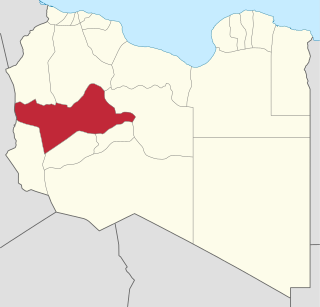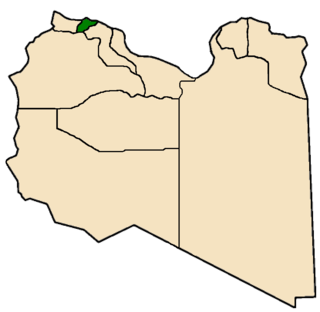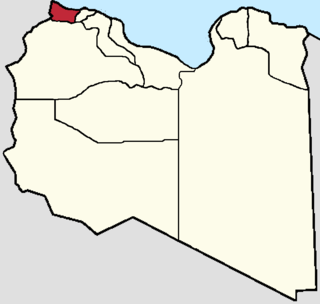
Sabha Governorate [1] (or Sebha Governorate) was one of the governorates (muhafazah) of Libya from 1963 to 1983. It was formed from part of Fezzan province. Its capital was Sabha. [2] In 1970, it had a population of around 97,000. [3]

Sabha Governorate [1] (or Sebha Governorate) was one of the governorates (muhafazah) of Libya from 1963 to 1983. It was formed from part of Fezzan province. Its capital was Sabha. [2] In 1970, it had a population of around 97,000. [3]

In Libya there are currently 106 districts, second level administrative subdivisions known in Arabic as baladiyat. The number has varied since 2013 between 99 and 108. The first level administrative divisions in Libya are currently the governorates (muhafazat), which have yet to be formally deliniated, but which were originally tripartite as: Tripolitania in the northwest, Cyrenaica in the east, and Fezzan in the southwest; and later divided into ten governorates.

Sabha, or Sebha, is an oasis city in southwestern Libya, approximately 640 kilometres (400 mi) south of Tripoli. It was historically the capital of the Fezzan region and the Military Territory of Fezzan-Ghadames and is now capital of the Sabha District. Sabha Air Base, south of the city, is a Libyan Air Force installation that is home to multiple MiG-25 aircraft.

Prince George Airport is an airport that serves Prince George, British Columbia, Canada, and the surrounding area. It is located just within the southern boundary of the city, 2.8 nautical miles southeast, and is run by the Prince George Airport Authority.
Ben Gardane or Bengardane is a coastal town in south eastern Tunisia, close to the border with Libya. It is located at around 33°8′20″N11°13′0″E.
The governorates of Libya (muhafazah) were a tenfold top-level administrative division of Libya from 1963 until 1983.

Muammar Gaddafi became the de facto leader of Libya on 1 September 1969 after leading a group of young Libyan Army officers against King Idris I in a bloodless coup d'état. After the king had fled the country, the Revolutionary Command Council (RCC) headed by Gaddafi abolished the monarchy and the old constitution and established the Libyan Arab Republic, with the motto "freedom, socialism and unity".

Derna is a port city in eastern Libya. It has a population of 100,000–150,000. It was the seat of one of the wealthiest provinces in the Barbary States, and remains the capital of the Derna District, with a much smaller area. Derna has a unique environment among Libyan cities, as it lies between green mountains, the Mediterranean Sea, and the desert. The city is also home to people of mixed origins.
Darnah Governorate was one of the governorates (muhafazah) of Libya from 1963 to 1983. It was created out of the Cyrenaica province. Its capital was the town of Derna.

Al Wahat or The Oases, occasionally spelt Al Wahad or Al Wahah is one of the districts of Libya. Its capital and largest city is Ajdabiya. The district is home to much of Libya's petroleum extraction economic activity.

Wadi al Shati, sometimes referred to as Ashati, is one of the districts of Libya in the central-west part of the country. The area is mostly desert. Wadi al Shati District is named after the depression of the same name, Wadi Ashati.

Libya–United States relations are the bilateral relations between the State of Libya and the United States of America. Relations are today cordial and cooperative, with particularly strong security cooperation only after the 2012 attack on the US liaison office or mission in Benghazi. Furthermore, a Gallup poll conducted in March and April 2012 found that Libyans had "among the highest approval" of US leadership in the entire Middle East and North Africa region.

Misrata Governorate was one of the governorates (muhafazah) of Libya from 1963 to 1983. Its capital was the town of Misrata. Initially in the 1930s was called "Provincia di Misurata" of Italian Libya. It was created out of the eastern part of Tripolitania province.

Tarabulus Governorate or Tripoli Governorate was one of the governorates (muhafazah) of Libya from 1963 to 1983. It contained the city of Tripoli, which was also its administrative capital. Tarabulus is the Arabic name for Tripoli, and was sometimes applied to the entire Tripolitania province.

Jabal al Gharbi Governorate or Jebal al Gharbi Governorate was one of the governorates (muhafazah) of Libya from 1963 to 1983. Its capital was Gharian. Other important towns in the governorate were Yafran, Nalut, Ghadames and Mizda. It was created out of the southwestern part of Tripolitania province.

Az Zawiyah Governorate was one of the governorates (muhafazah) of Libya from 1963 to 1983. Its capital was Zawiya. It was created out of the northwestern part of Tripolitania province.

Al Khums Governorate or Homs Governorate was one of the governorates (muhafazah) of Libya from 1963 to 1983. Its capital was the town of Khoms. It was created out of the Tripolitania province.

Awbari Governorate or Ubari Governorate Arabic: أوباري محافظة was one of the governorates (muhafazah) of Libya from 1963 to 1973. Its capital was the town of Ubari. It was created out of the southwestern part of Fezzan province. In 1973 the Awbari Governorate was merged into an altered Sabha Governorate.
Wissam Najm Abd Zayd al-Zubaydi, better known by his noms de guerre Abu Nabil al-Anbari, Abul Mughirah al-Qahtani or Abu Yazan al-Humairi was a commander in the Islamic State of Iraq and the Levant (ISIL) and the leader of its Libyan branch. Al-Anbari was killed by a US military airstrike on 13 November 2015.
This is a list of aviation-related events from 2016.
Hasan al-Salahayn Salih al-Sha'ari, known as Abu Habib al-Libi, is a Libyan man who has been a senior Islamic State leader in both Iraq and Libya.
Coordinates: 27°46′N15°40′E / 27.767°N 15.667°E